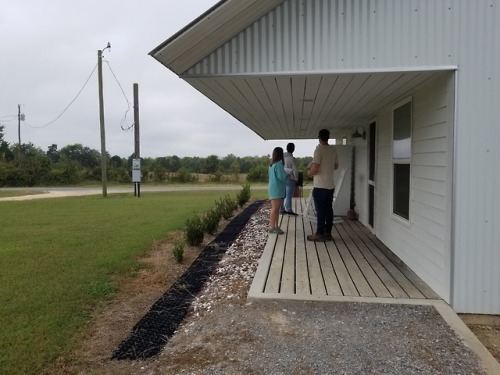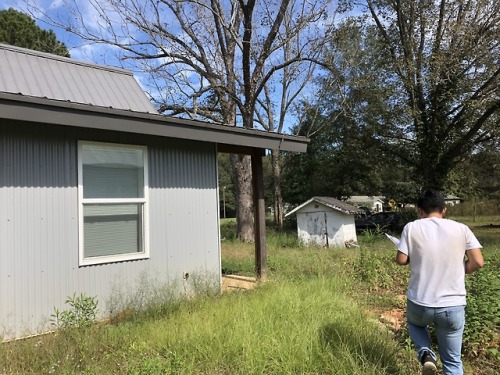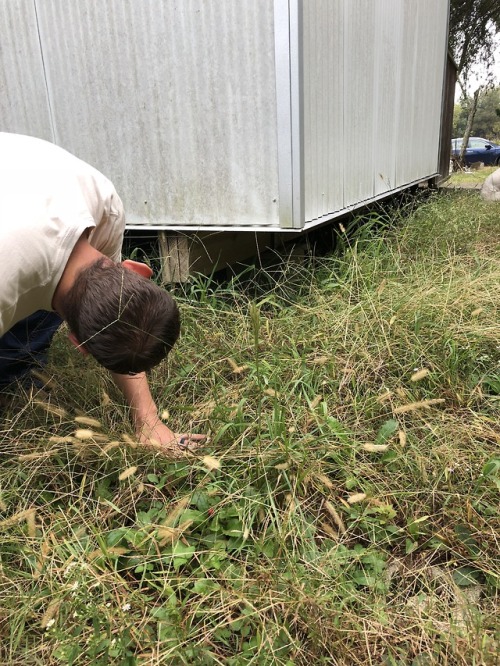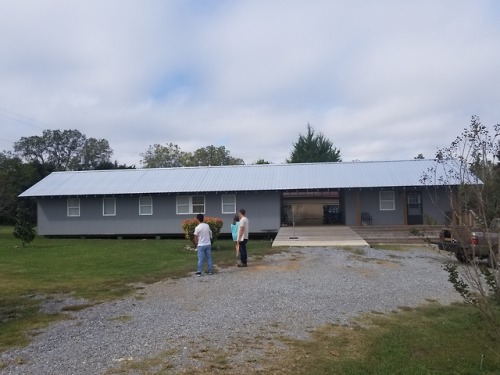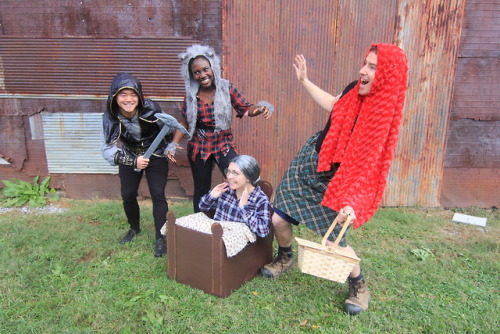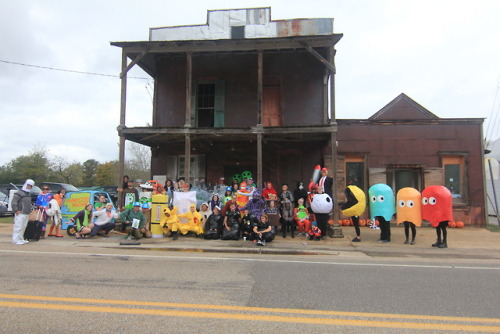#20kv23
The week after the break was a time for the team to get back together, finalize some decisions and get on site. We have began to engage more closely with the site, marking out the location of the house, where the driveway goes and presenting these suggestions to our client. With their blessing, we were able to move forward setting up a power pole and ordering materials to prepare the site for construction. We hope to be excavating, pouring footers and setting blocks in the coming weeks.







Our site has a beautiful view down a hill and across the road to a pasture, where a curious cow likes to come investigate the bobcat.


It’s been a busy few weeks so we’ve got some catching up to do! Spring break went by in a flash, and it was a much needed rest but now we are back and excited to be on site building a house. In the week leading up to spring break, we were able to meet our client and hear her story, which inspired us to push toward finishing her home.
Our client is a sweet lady named Debra, who became paralyzed at a young age. She lives with her husband on land that she owns with her sister. Her sister Jackie also lives on the site in a house with her daughter and grandson. Since Debra is bound to a wheelchair and her current home does not have a porch, it is difficult for her to experience the outdoors. We are excited that the home we have been designing for this purpose all year will be built for someone who is looking forward to being outside and enjoying the sun.



The 20K project is designed to be siteless and clientless, suitable for any homeowner or site in the region. The project has always emphasized the need for flexibility and adaptability, but it is now put to the test. Can a house designed so broadly become specific to one individual in a unique situation? We have received a truly beautiful site and couldn’t have asked for better clients, so we are so grateful for the opportunity to construct the home we have designed for them.
It’s been a busy couple of months since we’ve been back, but we’re finally getting around to sharing all that we’ve been up to! Strap in and get ready for all of the excitement and adventure that February held.
At the beginning of the month, we helped disassemble the Rural Studio exhibition at Birmingham Museum of Art. The installation used the quantity of lumber required to build Dave’s House, the eighth 20K, and turned it into a beautiful sculpture. Our team had the job of cataloging all the lumber and will have the privilege of reusing them for our own project. If Madeline is any good at counting, it looks like we should have all the studs for our house!

You can find more information about the exhibition here at https://artsbma.org/visitors-view-2xs-by-rural-studio/
Last you saw us, were constructing mock-ups to study two plan variations. Those helped us to understand how the spaces would really function, and we were able to make educated decisions about which one would best achieve our goals. We concluded that the nook on Edison provided just the right amount of privacy required by our project. Once we had a scheme chosen, it came time to work out every foot and inch of the plan, pushing and pulling every space until it became just right.
Besides constantly studying every inch of the plan, we began to develop how the house would look in three dimensions. What should the shape of the roof be? How can we make it contextual? How do we want our porch to feel? What should determine the height of our windows? How would we want our foundation to be?
To determine how to reinforce our concept with details, we began to draw and discuss them at 1:1 scale. Once we had a clear idea of how each detail should look, we constructed a detail mockup to practice and learn how we would put the house together.


With the assistance from the detailing dream team–Dan wheeler, Jake LaBarre, Joe Farrugia, and Emily McGlohn–we rolled into stress test with confidence and were able to have an incredibly productive conversation during our stress test review.

And yes, with the stubbornness of Jed we brought our tiny house all the way from Newbern, and up 4 floors to the review space. How it made it in there will remain a mystery.
Riding on the momentum of neckdowns, we have successfully crossed over another milestone. Our mockups are up and ready for more explorations! Thankfully the wind has been merciful to our hard work and left our structures grounded under the Fabrication Pavillion. We spent one day framing and one day wrapping plastic over the assembly before we were finally able to stage some helpful photos of the space to use in our presentation.




Having mockups of the living spaces and porches of both schemes was valuable to help this week’s reviewers understand them both. We appreciated the feedback from Peter Gluck and Rural Studio alumni, and enjoyed the rich discussion we were able to have. We hope the reviewers enjoyed seeing the work and had a great stay in Newbern!





Most of all, we’re excited to move forward with our decisions based on the work. Getting to inhabit the spaces ourselves made us confident that they achieve our goals, but were also surprising in some ways. The exercise has challenged us to rethink some of the relationships between spaces, but has affirmed many of our decisions. The process of building the mockups has also prompted the desire to begin thinking about connection details and more thoughtful window placements. We look forward to the upcoming steps in our design, like porch and roof design, as well as studying creative ways to use materials.
Hello and welcome back from the holiday abyss! Neckdown week is in full swing and the whole team is hard at work, taking a break from our own design to help out with other projects around Hale County. Tuesday, Kuan, Ayomi, and Madeline were all helping Eric down on the Farm, moving dirt to prepare the yard of Morisette Campus to grow food for us to eat this spring.





Jed was busy being the Bobcat Master, helping move pallets of lumber from the Fabrication Pavilion.

We’ve enjoyed getting to know the new class of third years by working with them this week, and we were also glad to be able to present our project to them last Friday. They’ll be continuing the work on their own 20K for Mrs. Patrick, an iteration of Mac’s Home begun by the third years in the fall. Follow their progress over at https://mrspatrickhome.tumblr.com/
Next week we will return to our own work by building mock-ups of the living and porch spaces of our two schemes. This will help us select a floor plan, and will help us understand the spaces we have designed more thoroughly. From this we can tweak and refine our design as we move closer to a finished product.
Never fear: 20Kv23 hasn’t frozen to death yet! Our homes may be frigid on arctic proportions, but Red Barn is aglow with the warmth of kerosene heaters. We’ve spent the week huddled around them as we explore oceans of floor plans and hone in on a layout. Iteration after iteration of schemes has produced a mountain of trace paper at the end of our desks. An inspiring lineup of visiting critics has narrowed our focus, but always leave us with new feedback to consider as we push our design forward.




If we learned one thing from our visits to 20K Homes, it is just how quickly life changes. It is impossible to plan for every possibility, so designing for aging in place demands a house that is flexible. To study this, we used three previous 20K plans that provided flexibility in certain areas, and created a series of drawings based on how they might be occupied by families of different sizes. Is there a space that could be turned into another bedroom? Can someone confined to their bed remain connected to lively public spaces? Imagining scenarios that demand different types of space showed us how tricky it will be to balance adaptability with privacy. Moving forward we will continue to develop two schemes that we believe are close to accomplishing those goals. Stay tuned for updates and excitement as Soup Roast approaches!



Happy November! Leading up to Halloween, 20K version 23 has been working hard on studying the development of the 20K project and the needs of aging-in-place. We had a great time dressing up for reviews, and enjoyed seeing our colleagues and professors looking just as ridiculous as we did. Congrats to the Moundville Pavilion ladies for their costume victory as Mount Rushmore! Check out their blog to see it at https://moundvillepavilion.tumblr.com/
To begin our study, we focused on wrapping our heads around the idea of aging in place. A home suitable for aging in place, or perhaps more accurately described as a “lifetime house,” is a home which can be modified over the lifetime of the inhabitant to better suit their changing needs. We discovered, for example, a home that is conducive for having children in your 30s may not work in your 50s when the kids are gone. Flexible spaces provide more long term opportunities. Being able to rearrange bedrooms into living rooms, and vise versa, creates a space to which your expanding or shrinking family can adapt. Likewise, as you enter your golden years and as the need for assisted living arises, this home can be ready for it. Wouldn’t it would be great if a house can age as gracefully as its occupants do?
To help us understand this idea, we examined past 20K houses and how they have changed and been adapted by their owners. Two days were spent touring around West Alabama to visit these homes and learn how they are used. Existing post-occupancy studies were examined and updated to see how certain homes have been reorganized over the years. We quickly realized the importance of understanding the different phases of life that we will need to design for. At the forefront of this discussion were adaptability and accessibility.
Moving forward with these studies and our review feedback, we are taking a step up in scale, studying new typologies for an adaptable home. Thoughtfully designing the adjacencies within the house will support flexibility over time. Understanding how flexibility will relate to the way the home fits into the rural community is perhaps even more important. The support structures that exist through family and neighbors is extremely tight-knit in rural communities, and understanding these relationships before we can add to this rural fabric is vital.
In its 25th year, Auburn University’s Rural Studio will be taking on the 23rd version of the 20K house. As a team, we are exploring the concept of aging-in-place and will have about a year to design and build a two-bedroom house that adapts and implements the research and ideas of the previous models. As fifth year students, we have the opportunity to be a part of another Rural Studio adventure and we are excited to meet this challenge.
Madeline understands that architecture impacts community and society and believes it can be used as a tool to improve them. In a complementary vein, she also uses her love of and skill for baking as a tool positively impact her friends. Her propensity for baking and general demeanor have affectionately earned her the nickname grandma.
Kuan’s passion for architecture stems from its highly multifaceted nature. He believes that good architecture requires mastery of all areas of knowledge. When he is not busy saving the world, he rides a bad-ass motorcycle, chasing the American dream.
WhenJed is not telling everyone about the time he was a Marine or surviving cancer, he enjoys trying to turn everyone into a vegetarian. Having a background in construction, he has become a wealth of knowledge when discussing construction details and woodworking. His plan while at Rural Studio is to design and construct dignified spaces while working on his tan.
A Nigerian princess herself, Ayomi is drawn to architecture for its combination of technical and aesthetic aspects and hopes to gain a greater understanding of the technical aspects from her time at rural. Being at Rural Studio is slowly changing her habits of lots of sleep and a strictly no veggie diet.


